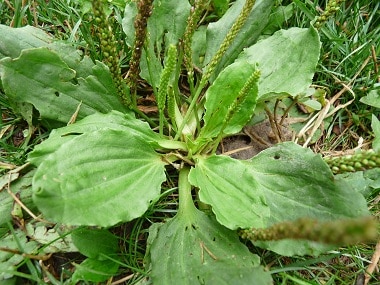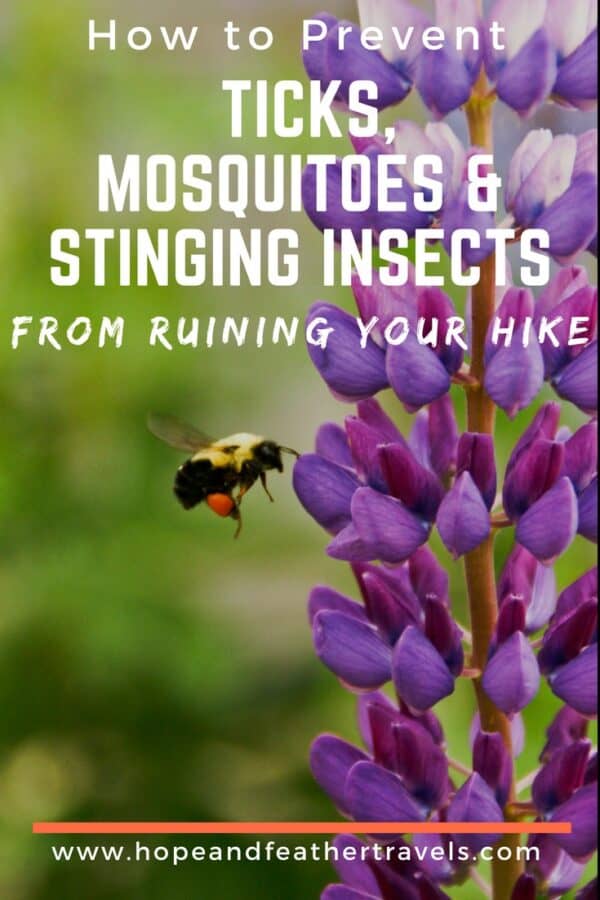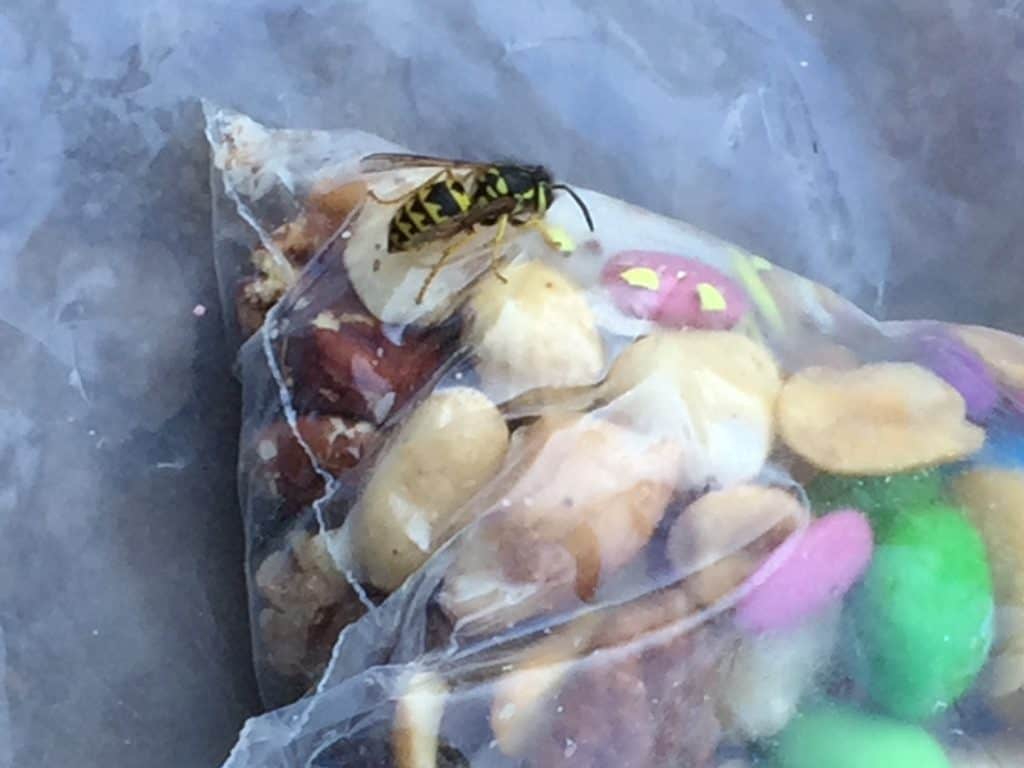Tick Prevention
When someone asks me if I’m scared of anything while I hike, my answer is always the same: Lightning and ticks. Ticks are often too small to see easily (the nymph stage of a deer tick, which transmits Lyme disease, is the size of a poppy seed!) and an unsuspecting sneak attack can afflict you with a life long, and possibly life threatening disease. Because of this, I take ticks very seriously when I’m in the woods. The following are what I deem best practices for prevention:
- Wear light-colored clothing so you can see a tick more easily.
- Wear pants and tuck your pants legs in your socks. Long sleeve shirts are a great choice as well.
- Treat your clothes with permethrin. The process is easy: Spray the clothing you’d like to treat per the instructions and let it dry. I like this popular product by Sawyer and we treated our clothing recently with it for a trip to Maine. Some will argue that it isn’t safe to treat your clothing and expose yourself to these chemicals, but I argue that tick-borne illness is way riskier. Some folks opt for a more economical route of treating their clothes and dilute concentrated permethrin themselves (0.5% is the dilution you’re after), but I haven’t gone that route yet.
- Purchase clothing impregnated with repellant. Ex Officio is a popular manufacturer of this type of clothing as well as Columbia. The biggest advantage of going this route versus treating your clothes after purchasing them is that the repellant lasts longer (Ex Officio claims 70 washes). You also avoid the DIY hassle factor, but you may pay more for the clothing.
- Walk in the middle of the trail and avoid brushing up against plants and grass where ticks like to hang out. Ticks also live in underbrush, so sitting during a break makes you more susceptible to one taking up residence on you. One of the most coveted items in my pack is my Therm-a-Rest Z Seat. I love it because it gives my butt a nice place to land during a break, but it also provides a small barrier between my body and the ground (although it is admittedly a false sense of security, so I always do tick checks after I’ve been sitting on a hike).
- Speaking of body parts, body scans to check for ticks after your hike are a great habit to get into (and even during your hike on your exposed skin). At home, do a much more thorough scan than you’re able to on the trail or in a parking area. Ticks are sneaky little demons so make sure to check places like your underarms, groin area, behind your knees, belly button, ears, scalp….and yes, even your butt crack!
- Do body scans on your dog if he/she came with you on the hike. This is important to keep your dog safe, but a tick crawling around on a thick coated dog may decide your sparsely haired skin is an easier target and jump from your dog to you!
- When you return home, remove your hiking clothing as soon as possible and wash it in hot water. There’s always the chance of bringing a tick home with you that hasn’t taken up residence on your skin yet. Check your backpack for ticks as well.
- Take a shower as soon as possible after a hike. This serves three purposes:
- It’s easier to do a more thorough body scan without clothes on.
- It will wash off any unattached ticks that you may not see otherwise
- You stink and will smell better to your family who didn’t go on the hike! 😉
- If you do find a tick attached to you, don’t panic. Any diseases ticks transmit doesn’t happen immediately and will take a minimum of 24 hours, and likely longer than that. Simply remove the tick by pulling directly upwards with tweezers or a tick removal device, if you like having something more official to do the job (but they are not necessary, in my opinion). Follow the removal by cleaning the area well with soap and water and applying some form of over-the-counter antibiotic ointment.
- If you remove a tick but find yourself afflicted with a rash, flu-like symptoms, or joint pain within a couple of weeks, see your doctor immediately to make sure you haven’t contracted a disease. The sooner treatment can be started, the better chance of success. Another symptom of Lyme disease that people can experience is paralysis/weakness of part of their face. This actually happened to me a year ago, and the first thing my doctor suspected was Lyme Disease, based on my lifestyle (thankfully, I tested negative and it was a short-lived case of Bell Palsy, probably secondary to a respiratory virus I had before the facial paralysis started).
Mosquito Prevention
All of the above recommendations apply to mosquitos as well. The only things I’d add to the list to prevent them from ruining your hike are:
- Carry a head net with you to prevent bites on your face and neck. They can get hot while you’re wearing one, but they sure are effective at keeping your sanity in check as mosquitos dive bomb your face.
- Google “natural mosquito repellant” on Pinterest and you will find no shortage of DIY recipes. Oil of Lemon Eucalyptus and Citronella are both touted to be as effective as 20-30% DEET which is quite impressive. If you’re not a DIYer but still want to try something with natural ingredients, my absolute favorite product is Bug Be Gone, created by the great folks at Hazelwood Soap Company.
- The EPA has a very helpful search tool to help consumers compare the various traditional products on the market. You can quickly whittle down which products protect against ticks versus mosquitoes, or both. It also provides the duration of action of the various products and the concentration of the active ingredient
- If you do use repellents, even those of natural origins, make sure you take steps to remove them from your body before swimming in lakes or streams. I’m a big fan of PackTowls for these types of tasks on my hiking and backpacking trips.
- Don’t take breaks or camp near stagnant water. Mosquitoes breed in stagnant water, so avoid it if possible.
- Peak feeding times for mosquitoes are during sunset and sunrise, if it’s possible to limit your exposure during these times of the day.
Bee Stings
A couple of years ago, my kids and I hiked the Foothills Trail with one of my besties and her kids. By the end, we weren’t sure our kids would ever set foot on a hiking trail again from all the yellow jackets we encountered (and were stung by many times). It opened up my eyes, literally, to a whole new way of scanning a trail when I hike.
- One of the best things you can do to avoid being stung by bees or disturbing a nest while hiking is to scan the trail in front of you for flying bees. Because many stinging insects (for example, yellow jackets) live in the ground, they are entering and exiting their nest constantly and can sometimes be seen before you approach an area. If you see the hole they’re coming from, make a broad swath around it to continue on the trail.
- If you are the unfortunate victim of disturbing a hive despite your best efforts to prevent it, run from the site as quickly as you can, but with caution so that you don’t fall and injure yourself more seriously than the bee stings!
- Wear light colored clothing. Bees have evolved to perceive dark colors as a threat, since mostly dark-colored mammals are what they will encounter. The color red is perceived as black by bees, so avoid wearing it in the warmer months when bees are most active.
- Don’t swat at bees. This tip is admittedly the most difficult for me, because my fear of being stung makes me perceive any bee as threatening. My kids prove that my fear is inflated though, as they are masters are sitting motionless if a bee is flying around them during a break, even if it lands on their body for a few seconds. If a bee doesn’t perceive you as a threat (and the number one trigger for perceiving you as a threat is if you are close to its nest), try to stay calm as its flying around you.
- Bodies of water are not a good place to “hide” from bees if they are in attack mode. They will often sit at the surface and wait for you to emerge.
- If you are stung by a bee, take an antihistamine as soon as possible. At a minimum, it will help reduce your local reaction to the sting as it evolves. If you react strongly to Benadryl (i.e. it puts you to sleep quickly or impairs your ability to hike safely), take a non-sedating type of antihistamine. Most serious reactions to bees will happen quickly, but its impossible to know if you may acutely become this allergic to bee stings. It’s a good practice to have an antihistamine in your system if you do react strongly, even if you have an Epi-Pen.
- Speaking of Epi-Pens, if you know you are allergic to bee stings, by all means carry one with you (carrying two is actually preferable, since the duration of time epinephrine stays in your system may not last long enough to get you out of the woods safely and to an ER). This is one of the reasons I recommend taking an antihistamine after you’re stung.
- Make sure the stinger is not lodged in your skin at the site of the sting. If it is, try to remove it. Some say a credit card works well to “scrape” it out efficiently.
Natural Remedies for a Bee Sting
Beyond medications in your first aid kit, here are a couple of things I have used on hikes when I’ve been stung:
- Cold water can be very soothing on a bee sting.
- I carry a small amount of baking soda in my first aid kid. I mix it with water to make a paste and apply it to the sting site. I’m always amazed at how helpful it is to manage the discomfort.
- Jewelweed is an effective pain reliever as well. If you use Jewelweed, take a stalk and cut it lengthwise or just tease it apart with your fingers. Inside, you’ll find a slightly sticky substance and that’s what you’re after. Apply it to the sting and you’ll have some degree of immediate relief. It’s short-lived relief though, so reapplying often is necessary to continue to manage the pain.

Jewelweed
- A poultice made from Broad Leaf Plantain is also effective in managing pain from a sting. To make a poultice, chew on some leaves of plantain to release the natural juices inside the leaves and then apply it directly to the sting site.

Broadleaf Plantain
Time spent in the backcountry is immensely rewarding, even with the annoyances and risks these tiny critters bring to the scene. Take the steps to stay sane when faced with them, enjoy your time in the backcountry, and please share any other tips and tricks you know about in the comments below!
Happy Trails, y’all!

Save it and share the love on Pinterest!
[content-upgrade id=”3141″]




